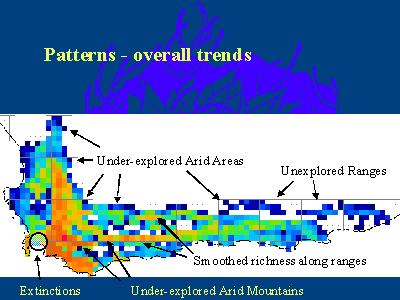|

Home
Mission
Overview of Project
Project Staff
Sponsors
Achievements
Checking, Illustrations
Upcoming Activities
Id and Species Lists
Protea Information
Protea Gallery
Growing Proteas
Interim Dist. Maps
Publications
Afrikaanse Inligting
SANBI
|
|

    |
 The
best way to summarize the achievements of atlassers and the Protea Atlas Project is to
look a the changes to the distribution patterns or patterns of biodiversity that we found.
(If you want to explore these more, see Worldmap)
The three most obvious impacts of the Protea Atlas Project were to discover:
That proteas were common on the GrootRivier and KleinWinterhoek
Mountains in the east of the region (where they had been barely recroded before on these
botanically unexplored ranges), and lots of new records (and new species) from the arid
interior regions of the area (under-explored arid areas).
At the same time the historical peaks in records from the mountains -
which showed were the mountain passes occurred, are now smoothed over along these mountain
ranges. Interestingly, the Riviersonderend Mountains were found to have been badly
explored, possibly because of the lack of free-flowing water in this range.
The unwelcome news was that the Cape Flats showed many extinctions.
Apart from the example of Diastella proteoides shown earlier, we also have Serruria
furcellata and Se aemula congesta which could not be found, despite many
searches within their known habitat. These two species must therefore be considered
extinct in the wild (two plants of Se furcellata are still growing at the nursery
at the University of the Western Cape - Kirstenbosch National Botanical Garden has
obtained cuttings from these). Many other species have had their distribution ranges
decimated in the Cape Flats.
|
Slide 16 of 24
|

![]()
